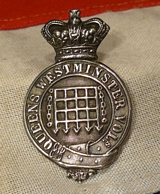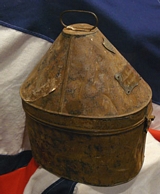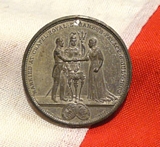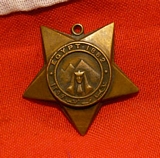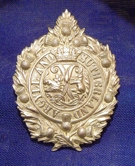Antique Arms & Militaria
A Nice Early 19th century, King George IIIrd Old Sheffield Decanter Coaster
a wine and spirit decanter gallery coaster in fine old plate, with deep turned carved mahogany base, pierced sides, multi ribbed rim edge and beize cloth on the bottom. Measures 5" in diameter x 2.25" tall. Excellent period condition. read more
220.00 GBP
A Very Fine Victorian Long Service Good Conduct Medal
Awarded to a Battery Quarter Master Sergeant in the Royal Field Artillery, the 1873 issue Medal. read more
185.00 GBP
The German Franco Prussian War Commemorative Medal of 1870/71
this is a campagian medal presented by Kaiser William I in his capacity as King of Prussia. The medal was presented to commemorate recipents service in the Franco Prussian War. The medal was presented to members of the united German armies. The medal was presented for combat service in gilt bronze, and non-combat service in steel. Each version bore minor differences in inscription and design. Claps were authorized on the 25th anniversary of the German victory, to commemorate selected battles. read more
75.00 GBP
A Superb 19th Century Britannia Metal and Brass Mounted Pistol Flask
A lovely flask, perfect for a set of cased pistols or a cased revolver etc. lacking a good flask. Excellent condition, with very good original gold lacquer finish to the brass. 4 inches long 2 inches across. Very small dent at the bottom on one side about 10mm x 5mm read more
295.00 GBP
Armouryantiques and militaria
The best militaria shop in the UK A Superb Case Hardened Steel Gun Lock Of a Greene Carbine 1856 Scarce British-Type Greene Carbine by Massachusetts Arms Company
Case-hardened swivel breech action with Maynard tape primer system. Lock marked: Queen's crown /VR/Mass.Arms Co./U.S.A./1856.
James Durell Greene was a prolific firearms inventor and determined to make his mark This carbine lock was manufactured by the Massachusetts Arms Company and exported to Great Britain after being inspected and stamped with the Queen's Crown by British inspectors in the USA. These were used by the British Cavalry in the Crimean War but re-exported to the USA after the Crimea War. These fine guns were deemed to be very accurate but the paper and linen cartridges of the time were criticised as being prone to swell in the damp and consequently the carbine did not find favour with the British Government. The carbine features an unusual "floating thimble" to obdurate the breech and an internal "pricker" that punctured the cartridge. It also featured Maynard Tape priming which was in the forefront of priming technology at the time and the mechanism for this is in perfect condition. The quality of workmanship is exceptional and it actions as crisply today as it did when it was made 158 years ago.
An exceptional item in outstanding condition. Only 2000 were manufactured and a complete carbine would be around ?3,000. read more
Price
on
Request
A Victorian, 1860's Queens Westminster Volunteers Silver Buckle
A super silver buckle, with excellent detail and quality. 6cm read more
120.00 GBP
A Victorian British Connaught Rangers Officer's Helmet Tin
the case which is emblazoned with the makers name Hawkes and a brass plaque with the officer's name and regiment engraved, Addis Delacombe Esq Connaught Rangers. The 1st Battalion deployed to South Africa as part of 5th (Irish) Brigade which was commanded by Major-General Fitzroy Hart. The Rangers took part in numerous engagements during the Boer War.
The regiment took part in the Battle of Colenso on 15 December, part of the attempt to relieve the town of Ladysmith, besieged by Boer forces. The Rangers and the rest of the 5th (Hart's) Brigade, who were on the left flank, had been forced to perform over 20 minutes of drill before the advance. The Brigade suffered heavily during their participation in the battle, the Boers inflicting heavy casualties. The advance was met with a fire from three sides that forced them to withdraw. The battle ended in defeat for the British. That battle and two previous defeats at Magersfontein and Stormberg became known as 'Black Week'.
The Rangers fought at Spion Kop and the Tugela Heights during further attempts by General Sir Redvers Buller to relieve the besieged town of Ladysmith. In late February the siege of Ladysmith finally came to an end after it was relieved by British forces. The regiment was awarded the battle honour Relief of Ladysmith in addition to South Africa 1899?1902.
The 5th Brigade subsequently deployed to Kimberley and took part in further operations against the Boer guerillas.
The Rangers finally departed South Africa for Ireland after the Boer War ended in 1902, and were also awarded the theatre honour.
In 1908 the 1st Battalion arrived in India while the 2nd Battalion returned home to Ireland. The 1st and 2nd battalions of the regiment were given new Colours by HM King George V in 1911. The 2nd Battalion had left Ireland and was in England when the "war to end all wars", the First World War, began in August 1914. This tin is in untouched condition and could be much improved with simple cleaning but we have left 'as is' for those that prefer it as such. read more
200.00 GBP
Historical Medal For the Marriage of the Duke of York & Princess Mary 1893
Married At Chapel Royal St James's Palace 6 July 1893. Reverse with Duke and Duchess standing before Brittania Made by Spink and Sons London. Silvered on metal. 51mm. read more
85.00 GBP
A Khedive Star Medal
Five pointed star with a central raised circle bearing an image of the Sphinx with the Pyramids behind, the word ?EGYPT? above followed by a year (for the first three issues and undated for the fourth) with the same written in Arabic below. The reverse has the monogram of the Khedive under a crown within a raised circle. The Khedive of Egypt presented a bronze star to all Officers and men of the Navy and Army who were engaged in the suppression of the rebellion of Egypt in 1882. The suspender [lacking] was straight with a crescent and five pointed star in the centre which is attached to the star with a small metal loop passing through a small ring between the two top points of the star. Ist issue dated 1882. Good Very Fine condition. No ribbon,mount.Unnamed as issued. read more
65.00 GBP
Argyll and Sutherland Highlanders Glengarry Badge 1882 to 1900 Pattern
In pressed nickel with good clear definition and in good condition, 2 lugs. read more
45.00 GBP







